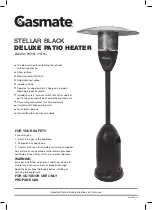
9
Sidewall separation
means the parting of the rubber
compound from the cord material in the sidewall.
ST tire
means a tire designed for use only on trailers drawn
on a road.
Test rim
means the rim on which a tire is fitted for testing,
and may be any rim listed as appropriate for use with that tire.
Tread
means that portion of a tire that comes into contact
with the road.
Tread rib
means a tread section running circumferentially
around a tire.
Tread separation
means pulling away of the tread from the
tire carcass.
Treadwear indicators (TWI)
means the projections within the
principal grooves designed to give a visual indication of the
degrees of wear of the tread.
Vehicle capacity weight
means the rated cargo and luggage
load plus 68 kilograms times the vehicle’s designated seating
capacity.
Vehicle maximum load on the tire
means that load on an
individual tire that is determined by distributing to each axle
its share of the maximum loaded vehicle weight and dividing
by two.
Vehicle normal load
on the tire
means that load on an
individual tire that is determined by distributing to each axle
its share of the curb weight, accessory weight, and normal
occupant weight (distributed in accordance with Table I of 49
CFR 571.110) and dividing by 2.
Wheel center member
means, in the case of a non-
pneumatic tire assembly incorporating a wheel, a mechanical
device which attaches, either integrally or separably, to the
non-pneumatic rim and provides the connection between
the non-pneumatic rim and the vehicle; or in the case of
a nonpneumatic tire assembly not incorporating a wheel,
a mechanical device which attaches, either integrally or
separably, to the non-pneumatic tire and provides the
connection between the tire and the vehicle.
Wheel-holding fixture
means the fixture used to hold the
wheel and tire assembly securely during testing.
4. TIRE SAFETY - EVERYTHING RIDES ON IT
The National Traffic Safety Administration (NHTSA) has
published a brochure (DOT HS 809 361) that discusses all
aspects of Tire Safety, as required by 49 CFR 575.6. This
brochure is reproduced in part below. It can be obtained and
downloaded from NHTSA, free of charge, from the following
web site:
http://www.nhtsa.dot.gov/cars/rules/TireSafety/ridesonit/
tires_index.html
Studies of tire safety show that maintaining proper tire
pressure, observing tire and vehicle load limits (not carrying
more weight in your vehicle than your tires or vehicle can
safely handle), avoiding road hazards, and inspecting
tires for cuts, slashes, and other irregularities are the most
important things you can do to avoid tire failure, such as tread
separation or blowout and flat tires. These actions, along with
other care and maintenance activities, can also:
• Improve vehicle handling
• Help protect you and others from avoidable breakdowns
and accidents
• Improve fuel economy
• Increase the life of your tires
This booklet presents a comprehensive overview of tire
safety, including information on the following topics:
• Basic tire maintenance
• Uniform Tire Quality Grading System
• Fundamental characteristics of tires
• Tire safety tips. Use this information to make tire safety a
regular part of your vehicle maintenance routine.
Recognize that the time you spend is minimal compared with
the inconvenience and safety consequences of a flat tire or
other tire failure.
SAFETY FIRST–BASIC TIRE MAINTENANCE
Properly maintained tires improve the steering, stopping,
traction, and load-carrying capability of your vehicle.
Underinflated tires and overloaded vehicles are a major
cause of tire failure. Therefore, as mentioned above, to avoid
flat tires and other types of tire failure, you should maintain
proper tire pressure, observe tire and vehicle load limits,
avoid road hazards, and regularly inspect your tires.
FINDING YOUR VEHICLE'S RECOMMENDED TIRE
PRESSURE AND LOAD LIMITS
Tire information placards and vehicle certification labels
contain information on tires and load limits. These labels
indicate the vehicle manufacturer's information including:
• Recommended tire size
• Recommended tire inflation pressure
• Vehicle capacity weight (VCW – the maximum occupant
and cargo weight a vehicle is designed to carry)
• Front and rear gross axle weight ratings (GAWR – the
maximum weight the axle systems are designed to carry).
Both placards and certification labels are permanently
attached to the trailer near the left front.
UNDERSTANDING TIRE PRESSURE AND LOAD LIMITS
Tire inflation pressure is the level of air in the tire that
provides it with load-carrying capacity and affects the overall
performance of the vehicle. The tire inflation pressure is a
number that indicates the amount of air pressure– measured
in pounds per square inch (psi)–a tire requires to be properly
inflated. (You will also find this number on the vehicle
information placard expressed in kilopascals (kpa), which is
the metric measure used internationally.)
Manufacturers of passenger vehicles and light trucks
determine this number based on the vehicle's design load
limit, that is, the greatest amount of weight a vehicle can
safely carry and the vehicle's tire size. The proper tire
pressure for your vehicle is referred to as the "recommended
cold inflation pressure." (As you will read below, it is difficult
Not for
Reproduction










































